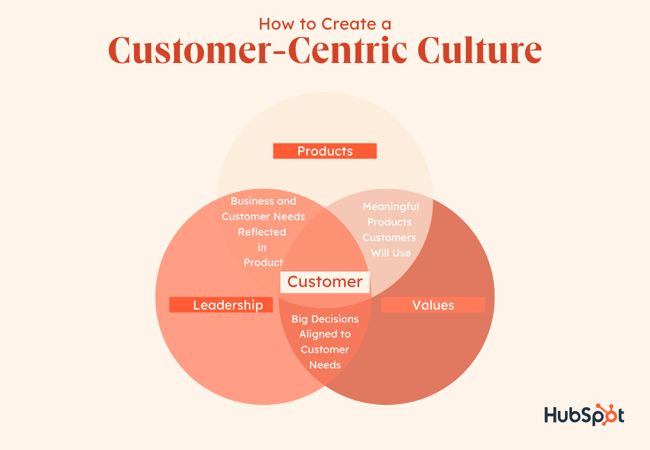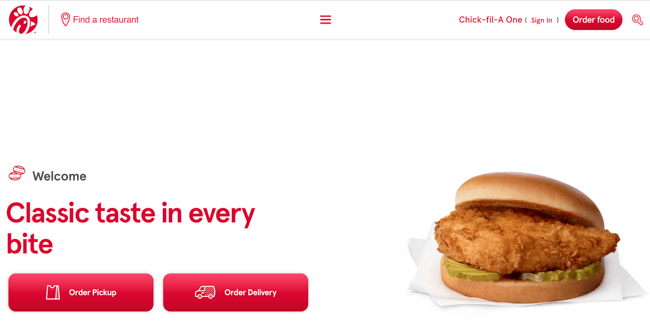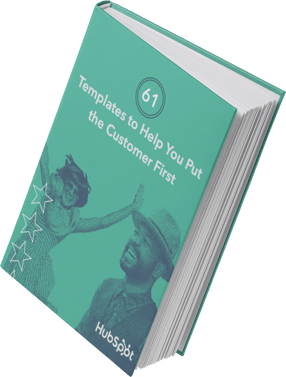Twice a month, I receive a message at the top of my Inbox from Gusto with the headline: "🎉 Hooray! Ben, you got paid today."

It's a simple product feature, but regardless, it brings a smile to my face. The HR software is demonstrating a customer-centric framework by celebrating what is normally an insignificant moment for companies, but a meaningful day in the lives of employees.
Gusto understands that when employees are happy, companies (Gusto's customers) are happy. By going the extra mile, a core value of their brand, they are able to build experiences that please time and time again. Brands that take the steps to please the customer in every encounter — from in-app copy to email drips and phone calls — understand the importance of customer centricity.
And today, being acutely aware of service is more important than ever. So as a leader, how do you build and maintain an organization that not only emphasizes customer service but fosters a customer-oriented outlook at every possible moment? By building customer-centricity into the DNA of your business.
What is Customer-Centric?
Customer-centricity is a business framework that fosters a positive customer experience at every stage of the customer journey. The goal of a customer-centric business is to build customer loyalty and advocacy. Anytime a customer-centric business makes a decision, it deeply considers the effect the outcome will have on its customers.
.webp?width=650&height=649&name=HubSpot-English-Inbound-Methodology%20(1).webp)
Building a customer-centric organization in today's digital world is increasingly complicated. While new technologies have allowed companies to roll out changes quickly, there's now an expectation from customers for greater attention.
Why Customer Centricity Is Important
There's a whole host of reasons that motivate entrepreneurs to create new enterprises — passion, money, fame, glory, independence. But regardless of the motivation behind the establishment of a company, there's one tenant that's common to all enterprises:
If you don't acquire and retain customers, you won't survive.
And from this simple statement, you can understand the importance of a customer-centric approach to business. An organization that forgets about customers is destined to fail. They'll build the wrong products, invest in the wrong resources, and lose goodwill with customers.
A customer-centric brand proves quite the opposite case. Every team member listens to customers and is aligned on that goal. In turn, the company builds products that meet customer needs, anticipates customer wants, and they provide a level of service that keeps customers coming through the door and advocating for the brand.
So, how do you keep up with this modern workplace challenge? Create a customer-centric culture.
Featured Resource: 61 Free Customer-Centric Templates
Click here to download free customer survey, email, and profile templates.
The Value of a Customer-Centric Culture
If your goal is to become a customer-centric organization, there's one sure fire way to make the value spread like wildfire through your organization: Make it a core value. By including a customer-focused core value, you'll have a vision that the whole team can get behind. Literally putting your value up on the wall and your website commits the concept to your leadership, your entire team, and your customers.

At Proof one of the core values is "be customer obsessed." Everyone knows the value by heart, and we can use it as a reference point every day at work. If we're deciding on a feature to launch or whether to pursue a partnership, we can ask "Does this help our customers?" If the answer is no, we generally stay away from it. That guiding question has helped us build a customer-centric culture on our marketing, sales, and customer service teams.
The Customer-Centric Strategy
Having a solid strategy for customer centricity is key to executing it properly. The two primary ways you can center the customer within your business include customer-centric marketing and customer-centric selling.
Customer-Centric Marketing
Customer-centric marketing is a strategy that includes the customer in the company's messaging. User generated content, customer feedback, and reviews are tactics that can be used in customer-centric marketing. The goal of customer-centric marketing is to turn customers into promoters that generate new customers through referrals from word-of-mouth.
Customer-centricity doesn't stop with your marketing efforts, though. Your sales team can also get on board with this strategy.
Customer-Centric Selling
Customer-centric selling is a strategy tailored to prospects' needs and desires. The goal of this strategy is to solve for the prospect rather than sell a one-size-fits-all package. Customer-centric sales reps will proactively share helpful content through channels like email, LinkedIn, text, and in-person or virtual events rather than cold-calling prospects.
And when someone does something that benefits our customers, we celebrate that victory as a team — because a win for our customers is a win for our team.
If you're looking to develop the same approach for your business, take a look at the next section for the steps your team can take to become customer-centric.
61 Templates to Help You Put the Customer First
Fill out the form for free email, survey, and profile templates.
How to Become a Customer-Centric Company
As we mentioned in the last section, customer-centricity begins with your company's culture. If your goal is to learn how to be customer-centric, then your business needs to make a company-wide commitment to your customer's success. The steps below explain what your organization can do to make that commitment to your customers and examples of how top brands put customers at the center of everything they do.
1. Anticipate Customer Needs
There's a great quote from Henry Ford that says:
"If I had asked people what they wanted, they would have said faster horses."
You may be wondering why I am bringing this up when it seems counter-intuitive to the concept of customer-centricity. But hear me out:
Ford is saying that if he had only listened to what customers thought he could build, he wouldn't have produced a car. He was thinking light-years ahead of his competition, and for that reason he created a product that anticipated the market's future needs. Ford knew what the customer wanted before the customer knew they even wanted it — that's a game-changing business move.
We can see similar styles of future-forecasting in Steve Jobs and Elon Musk. These visionary CEOs pushed the envelopes on what people would want in the future, giving the world the iPhone, iPad and the Model X — and companies with valuations of $1.08 trillion and $48 billion, respectively.
While most customers are able to accurately provide an account of what they want today, gauging what they want on a longer time horizon is extremely difficult for most people. They rely on companies to do that work for them to anticipate their needs — and make helpful suggestions accordingly.
2. Collect Customer Feedback
It may seem obvious, but to create a great, customer-centric company, you need to communicate both frequently and regularly with your customers.
In today's digital world, there are countless encounters where you can collect feedback. Here are a few touchpoints that you might already use to communicate with customers:
- Chat
- SMS
- Phone calls
- In-app messages
- FB Messenger
- Message boards
Today, valuable communication can occur on so many different platforms.
Every department should be using all of the communication channels at their disposal to learn about customers — and the sheer volume of quantitative insight you receive from these messages can help you greatly as you adjust your product roadmap.
But there's also a level of qualitative feedback that you need to be proactive about collecting. While the aforementioned communication is likely already occurring at your company, user research is something you might be ignoring.
Here are three customer research techniques to consider if you're not already:
Conduct a Survey
By telling your customers that you're not perfect, you can gain insight and track your performance. The most successful companies in the world already know the value of surveys, and by conducting a regular customer satisfaction survey or product survey, you can provide an avenue for great feedback.
Launch User Testing
Ask any designer or PM the value of user testing, and they'll sing their praises. Modern digital marketing tools such as Usertesting.com and Hotjar provide a simple framework to collect feedback from real people about your product. In the quest to build a customer-centric organization, this can help validate your hunches and guide your work towards the highest-impact projects.
Make Direct Calls
Have a friend that always insists on talking over the phone rather than text? I'd take a gander that that friend is one of your closer confidants. There's something more personal about a conversation outside of the digital realm — by simply picking up the phone, you're able to get a more robust form of feedback from customers.
And an added plus? You can adjust your line of questioning in real-time to adapt to each situation.
Our CTO J.P. Morgan practices this technique weekly — and he swears by the feedback he collects from his customer calls:
"Talking to customers is probably the most important thing I do all week. While there's a level of product development that requires you to take a stance and anticipate needs — it's impossible to do that without an understanding of your customer's current situation."
3. Be Easily Accessible
We all know the concept: make it difficult to contact support, and you'll spend less time servicing those difficult customers.
There's a huge financial and time expenditure used in servicing customers, so many brands (especially digitally-built businesses) hide their support behind many layers of pages.
For instance, try to find a phone number on Facebook's Help Page. It's nearly impossible. They'd rather communicate through help articles and live chat before giving out their number.
On the other spectrum, there's Zappos, the online shoe retailer with a completely opposite approach to customer success.
Zappos identifies that when a customer wants to talk to them, they should make it as easy as possible. Note how they include their phone number prominently on the top bar of every page with the note "Available 24/7."
Tony Hsieh, the CEO of Zappos, describes his rationale for that decision as:
"A lot of people may think it's strange that an internet company would be so focused on the telephone, when only about 5% of our sales happen by phone. But we've found that on average, our customers telephone us at least once at some point, and if we handle the call well, we have an opportunity to create an emotional impact and a lasting memory … Our philosophy has been that most of the money we might ordinarily have spent on advertising should be invested in customer service, so that our customers will do the marketing for us through word of mouth."
Make sure your ‘Contact Us' page is highly visible and easy to access — and that it actually answers common customer questions you see crop up time and time again.
4. Meet With Customers In-Person
One of the biggest epidemics facing modern organizations is the loss of feedback from in-person meetings. Looking back 50 years, before the advent of the Internet and our diversified global economy, it was far easier for a business to interact with an end customer.
Direct, human contact happened on a daily basis simply because it was a necessary part of commerce. If you wanted an item, you went to a store, talked to a salesperson, and bought it in-person. That feedback could be used by a business to improve the consumer experience.
Today, in most businesses, this is not the case. Don't get me wrong, the other advances from the digital economy have provided great benefits. While your potential touchpoints for feedback are far greater due to technology, there is less in-depth contact.
How do you combat this? By bringing back the in-person experience.
It may seem old school, but hosting in-person events can be beneficial in your quest to customer centrism. By hosting an event, you provide value to two parties: the customers and the brand.
For instance, consider Sofi's initiative to host community events across the country. While it's likely a substantial expense, there's a positive externality. And they don't hide it. They claim the benefits of a direct channel to interact with and get feedback from their members, as well as a way to build brand affinity. Not to mention, it's lots of fun, too.
5. Provide Proactive Customer Service
One of the best ways to differentiate your business from its competitors is to provide your customers with added value that extends beyond the point of purchase. This shows them that you're truly invested in creating a delightful customer experience and will go above-and-beyond to deliver it to them.
One way to provide added value is to include proactive customer service features. Proactive customer service gives your customers resources that help them solve problems on their own, without having to reach out to your business for support. This way they can resolve simple issues and avoid waiting on hold for your customer service team.
WashCard Systems is one company that has profited immensely from adopting proactive customer service. They used HubSpot to create a pricing page so customers wouldn't have to reach out to a live rep to see how much its products cost. This accelerated the company's sales process as customers knew immediately whether or not WashCard Systems would fit their budget.
A pricing page may seem like a simple addition, but it completely changed WashCard Systems' lead generation process. In 2018, the pricing page became the website's most visited page and was responsible for nearly two-thirds of the company's online conversions. Rather than dissuading customers, the pricing page encouraged them to reach out to WashCard Systems and learn more about what the business had to offer. This type of proactive customer service demonstrated the business's customer-centric approach to improving the buying experience.
6. Adopt Customer Service Tools
The customer's experience with your brand is just as important as the product or service you're providing. Customers don't just want a sale, they want to enjoy the entire buying experience. Even if your product is great, you'll lose customers to competitors who are able to make their customer interactions enjoyable and productive.
Adopting the right customer service tools plays a major role in creating a customer-centric experience. These tools help customer service teams create seamless, omni-channel support systems that provide customers with immediate solutions to their problems. By doing so, customers are more satisfied because the business is investing in their short- and long-term success.
One company that does an excellent job of utilizing customer service tools is the insurance company, Lemonade. Lemonade recognized that one of its most difficult challenges was changing the customer's perception of its industry. Most people loathe speaking with insurance companies because the customer experience is typically dull and frustrating. So, Lemonade invested in chatbots to help change that experience for its customers.
Lemonade's chatbot, "Mia," creates a light-hearted and friendly conversation with its users. Mia provides customers with clear and concise answers and advises them on plans that will best fit their budgets.
In an interview with HubSpot's The Growth Show, the company's CEO, Daniel Schreiber, highlighted that this chatbot has made their customer service experience more "playful and instantaneous." Additionally, Lemonade has been able to cut costs and reduce prices for customers as a result of added automation.
7. Look Beyond the Purchase
At the end of the day, your business's goal is to get customers to purchase your product or service. However, when customers buy once, you'll want to ensure they buy again. After all, studies show that it costs nearly five times more to attain a new customer than to retain an existing one.
But, how do you motivate your current customers to purchase from you again? Well, the best way is to provide them with added benefits that extend beyond the point of purchase. These benefits should help customers achieve their goals and create a more memorable customer experience. By doing so, customers will begin to affiliate their success with your company's products and services.
One example of this can be seen with the industrial clothing company, Rocky Mountain Industrial Supply, or RMI. RMI sells flame-resistant clothing to labor crews operating in industrial worksites like oilfields and mines.
In addition to its clothing, RMI creates added value for its customers by providing them with free safety certification courses. Customers take these courses to receive credible certifications that will qualify them to operate a product or piece of machinery. This not only helps customers avoid costly mistakes but also gives them the tools needed to excel in their careers. As they take more courses and enhance their skill set, customers begin to rely on RMI to assist with their long-term goals.
8. Create an Onboarding Process
If you want to create a customer-centric culture, your team can't abandon customers after you make a sale. Instead, make sure your customers get the most from your product and services. That way they'll be more inclined to return to your business when they're ready for an additional purchase.
One of the best methods for optimizing your product's value in the eyes of the customer is setting up a detailed onboarding process. An onboarding process introduces your products and services to the customer and explains how to use them to fulfill their specific needs. Each customer's needs will be unique, so your team should personalize this process to ensure every customer is properly set up for success.
One company that has profited from adopting an onboarding service is the SaaS business, Chargebacks 911. Chargebacks 911 used HubSpot's flywheel concept to analyze different pain points in the customer's journey. After assessing their sales and marketing tactics, Chargebacks 911 realized a major flaw in its customer experience: new customers were churning during the setup process.
To remedy this, the company decided to enact a new policy where the customer's sales rep would assist during the onboarding process. The benefit of this was that the sales reps could reference customer needs outlined during previous interactions. Then, the onboarding rep could identify products and features that would help the customer fulfill those needs. This ensured Chargebacks 911's customers were deriving the most value possible from their purchases.
Measuring the Success of Customer-Centricity
Many of the benefits of a customer-centric strategy come in the form of anecdotal evidence or from brand recognition, but there are tangible ways to determine whether your customer-focused efforts are working.
1. Customer Loyalty Programs
Loyalty programs are a great way to understand customer behavior which makes them prime for measuring the effectiveness of a customer-centric strategy. You can compare customer behaviors like purchase amounts or time-to-close before and after you've implemented the strategy to assess how well it's working.
2. Customer Support Time
It's inevitable that customers will experience a problem at some point, but the way those problems are solved can be a tell-tale sign of how well your customer centric efforts are going. If you find that customer service reps are spending less time per call or are receiving fewer calls overall, that's a good sign.
3. NPS Surveys
See what your new and existing customers think about your company with a net promoter score survey. This survey not only tells you how much they like doing business with you, it tells you how likely they are to advocate for your business to their friends and colleagues.
More Customer-Centric Company Examples
1. Chick-Fil-A

Chick-Fil-A's dedication to the customer experience is what makes them an example of a customer-centric company worth studying. The customer is prioritized from the moment they place their order on the app, at the drive-thru, or in-store by personalizing their order with their name. From there, the order is hand-delivered to the customer (no bags sitting on the counter here!) before they're wished a heartfelt farewell. Occasionally for app users, managers that the customers most frequented location will offer rewards that keeps them coming back for another great experience.
You can implement a cheerful customer-centric like Chick-Fil-A by paying close attention to a few things:
- Attentiveness: Whether your customer is a party of one or a large corporate entity, show attention at every stage of the customer journey. Use personalized direct mail and proactive phone calls to show clients your undivided attention.
- Speed: Consider the time it takes your customer to make a purchase or solve a problem with a past purchase. If there are any redundancies or unnecessary steps, work with your team to eliminate them.
- Generosity: Although you're in the business of making money, you could stand to gain more customer loyalty and advocacy when you share the wealth. You could choose to give meaningful rewards to your customers, or even donate to a charity of their choosing.
2. Spotify

Whether you use it to download the latest My First Million podcast episode or listen to the latest hits, you can be sure Spotify's algorithm is working overtime to curate a playlist that's unique to your tastes. The day-to-day experience isn't the only way Spotify displays customer-centricity, it pushes the envelope on customer advocacy in a unique way with Spotify Wrapped. This end-of-the-year compilation of your favorite audio is presented in an engaging format that's easy to share on social media which makes it a fun community experience that furthers Spotify's customer loyalty and growth.
If you want to generate customer advocacy as a result of the customer-centric strategy, try these tactics:
- Build Community: Your customers don't have to feel alone after they've made a purchase. You can start a moderated Slack channel or Reddit thread for community support which can lead to new innovations in your product or service.
- Encourage Customer Advocacy: If your organization doesn't have user-specific data that can be shared in a fun and engaging way like Spotify, you can still encourage customer advocacy by asking them to write reviews on public platforms like Yelp, Google Play, or Facebook.
Build a Culture that Values the Customer
The customer-centricity framework can help the smallest and largest companies attract, engage, and delight their customers. When your team is aligned with the customer's needs, you'll reap the rewards of loyal customers who become advocates for your brand. Use this guide to inform your next strategic planning session.
Editor's note: This post was originally published in May 2019 and has been updated for comprehensiveness.












